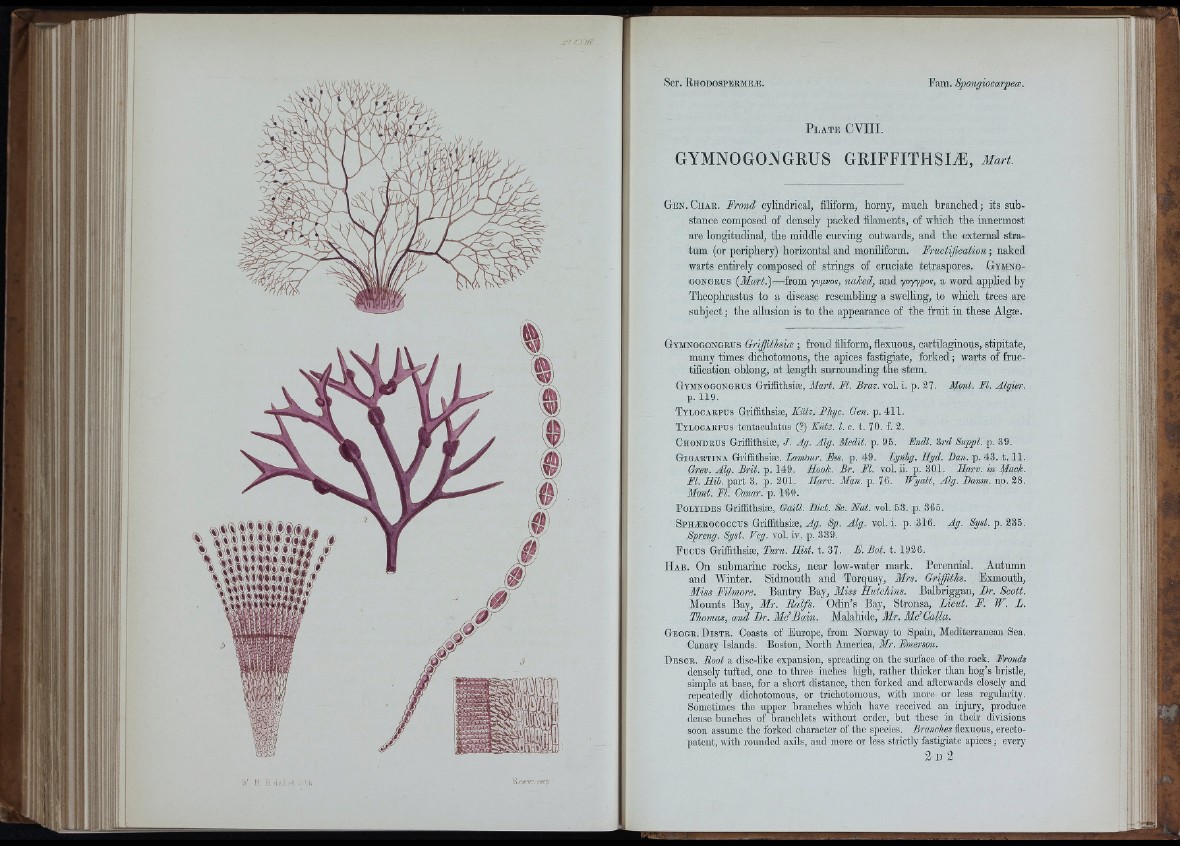
nil
P l a t e C V I I I ,
GYMNOGONGRUS GRIFFITHSIÆ, Mart.
G e n . C h a e . Frond cyKndrioal, filiform, horny, much branched ; its substance
composed of densely packed filaments, of which the innermost
are longitudinal, the middle curving outwards, and the external stratum
{or periphery) horizontal and moniliform. Fructification ; naked
warts entirely composed of strings of cruciate tetraspores. G ym n o -
GONGiius [Mart.)—from yvgvos, naked, and yoy ygoi, a word applied by
Theoplirastus to a disease resembling a swelling, to which trees are
subject ; the allusion is to the appearance of the fruit in these Algæ.
Gymnogongeus Ckrifiìttma ; frond filiform, flexuous, cartilaginous, stipitate,
many times diohotomous, the apices fastigiate, forked ; warts of fructification
oblong, at length surrounding the stem.
G ym n og ong kus GriffithsiiE, Mart. M. Braz.ycA.i. p. 3 7 . Mont. FI. Algkr.
p . 1 1 9 .
T yloc -VEPUS GriffithsiiE, Kiitz, Phyc. Gen. p . 4 1 1 .
T y lo c ak p u s tentaculatus (?) Kiitz. I. c. t. 70. f. 3.
Chondkus Griffithsim, J. Ag. Alg. Medit. p. 95. Endl. 3rd Suppl. p. 39.
G ig a e t in a Griffithsire. Lamour. Ess. p. 49. Lynhg. Hyd. Dan. p. 43. 1 . 11.
Ch-ev. Alg. Brit. p. 149. Hook. Br. El. vol. ii. p. 301. Harv. in Mack.
El. Hib. part 3. p. 201. Harv. Man. p. 76. Wyatt, Alg. Damn. no. 38.
Mont. El. Canar. p. 160.
P olyides Griffithsiae, Gaill. Diet. Sc. Nat. vol. 53. p. 365.
SpiijEEOCOOOUs Griffithsiae, Ag. Sp. Alg. vol.i. p. 316. Ag. Syst. p. 235.
Spreng. Syst. Veg. vol. iv. p. 339.
P u cu s GriffithsiiE, Turn. Hist. t. 37. E. Bot. t. 1926.
H a b . On submarine rocks, near low-water mark. Perennial. Autumn
and Winter. Sidmouth and Torquay, Mrs. Griffiths. Exmouth,
Miss Filmore. Bantry Bay, 31iss Huichins. Balbriggan, Dr. Scott.
Mounts Bay, Mr. Balfs. Odin’s Bay, Stronsa, Lieut. F. W. L.
Thomas, and Dr. MdBain. Malahide, Mr. M d Calla.
G e o g e . D i s t e . Coasts of Europe, from Norway to Spain, Mediterranean Sea.
Canary Islands. Boston, North America, Mr. Emerson.
Desor. Root a disc-like expansion, spreading on the surface of the rock. Eronds
densely tufted, one to three inches high, rather thicker than hog’s bristle,
simple at base, for a short distance, then forked and afterwards closely and
repeatedly diohotomous, or tricliotomous, with more or less regularity.
Sometimes the upper branches which have received an injury, produce
dense bunches of branchlets without order, but these in their divisions
soon assume the forked character of the species. Branches flexuous, erecto-
patent, with rounded axils, and more or less strictly fastigiate apices; every
2i ) 2
'.i
i t
f .,1 if
to H :i nrJ 4 ■■ R.eevi; imp